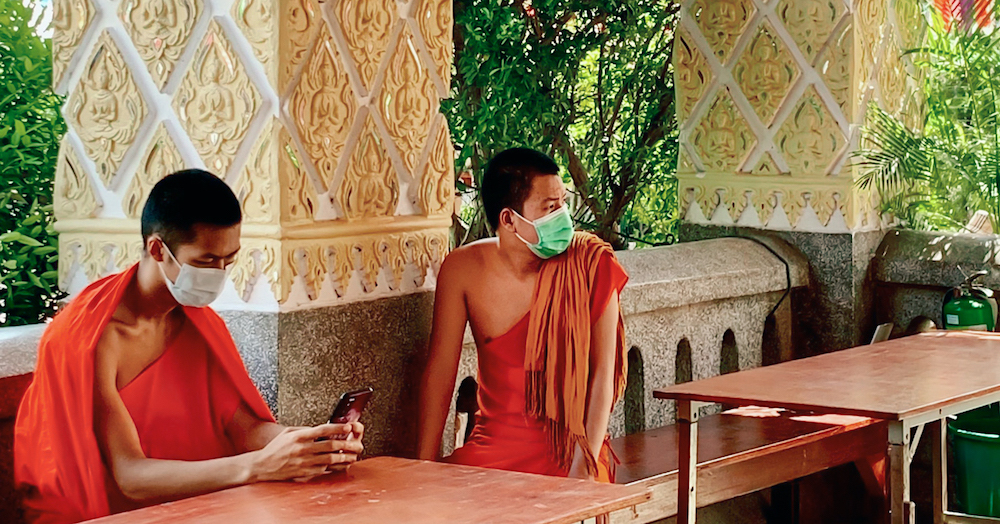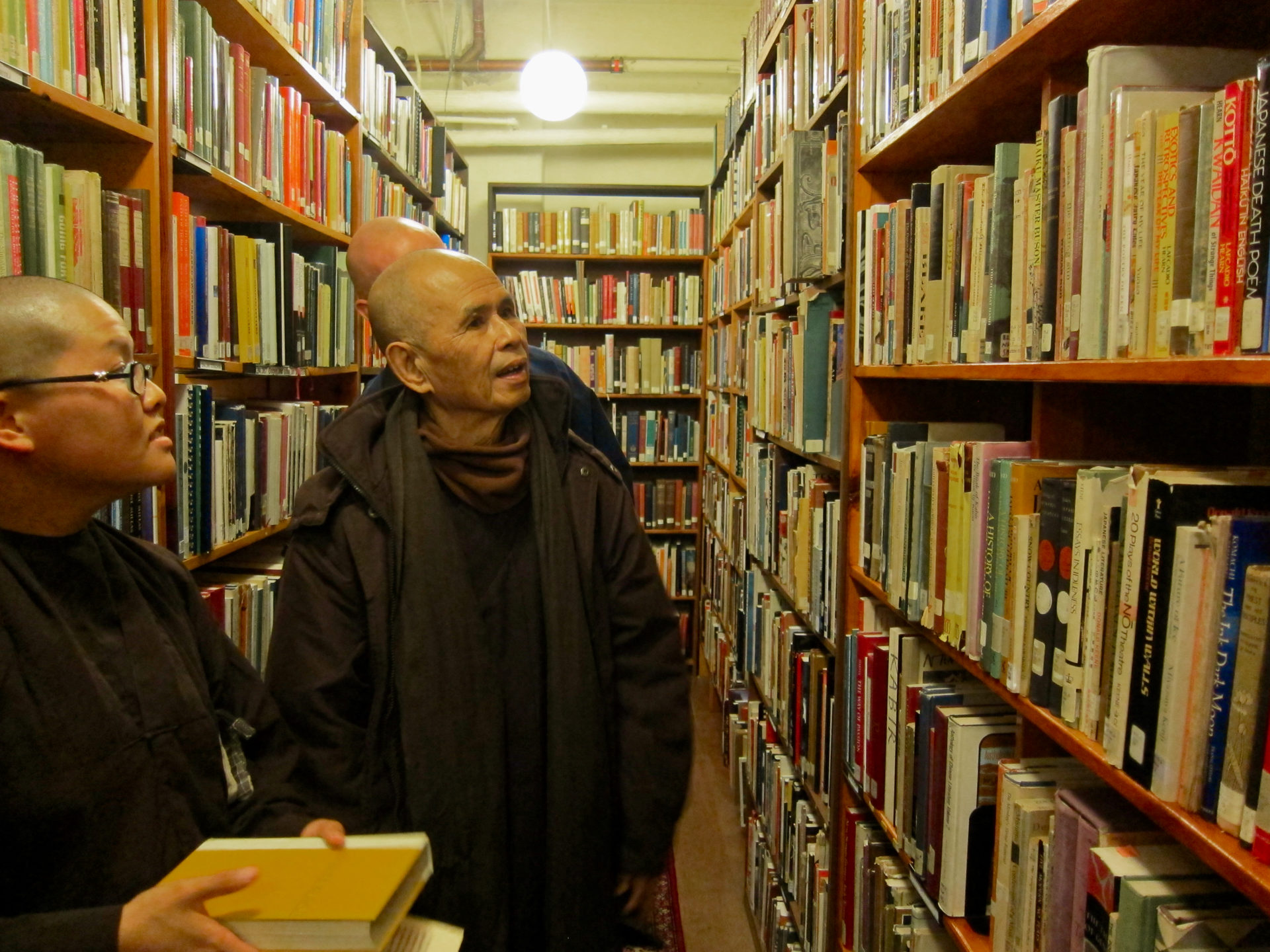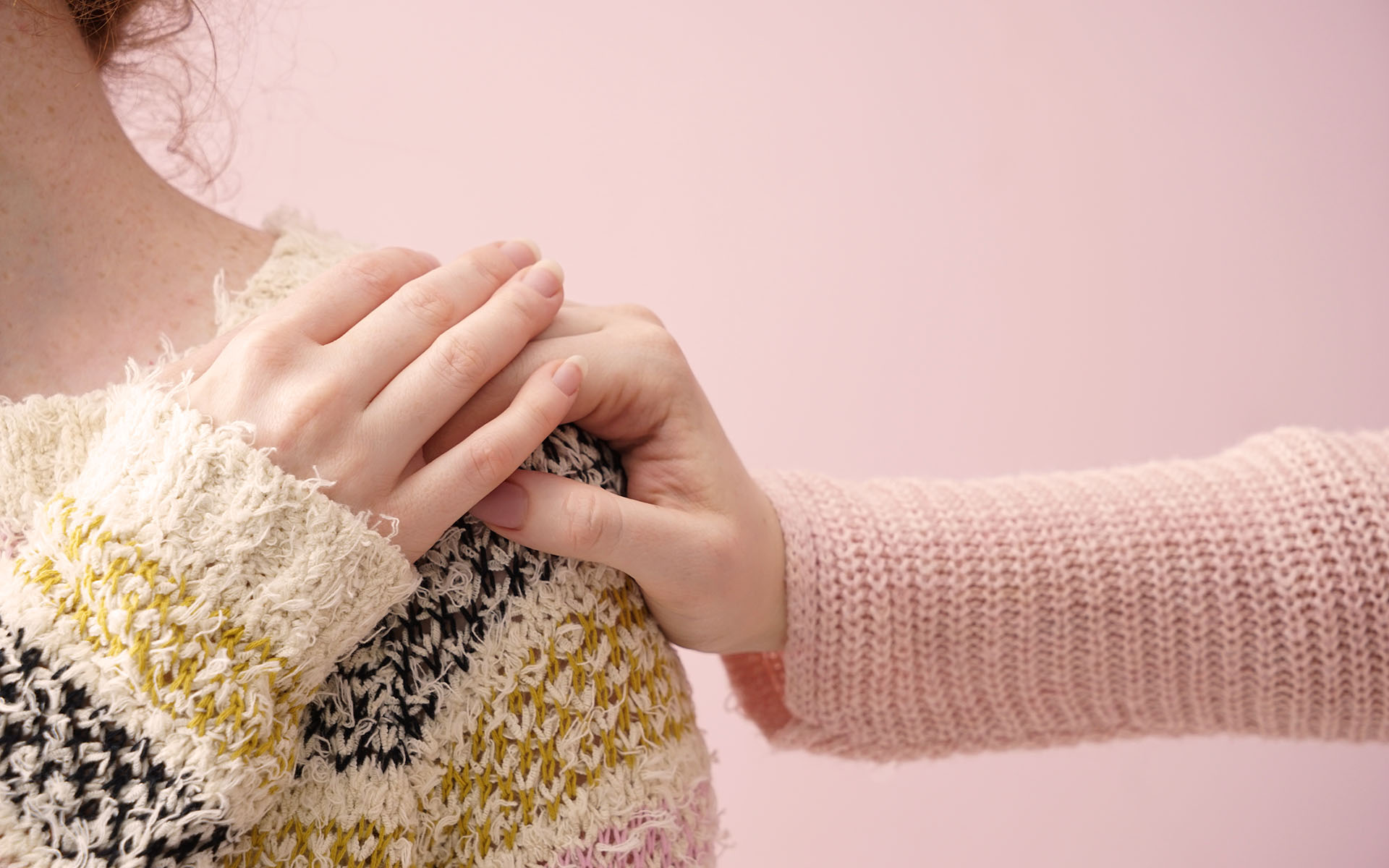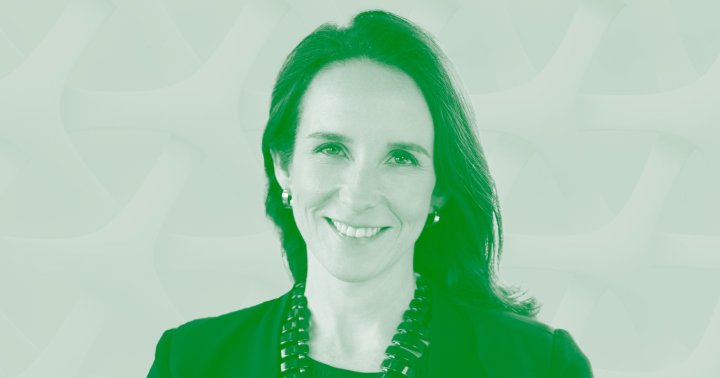COVID Inside the Monastery
Thai monks recount their experience during the pandemic The post COVID Inside the Monastery appeared first on Tricycle: The Buddhist Review.

March 13, 2023 marks three years since COVID was first declared a national emergency in the US. This week, we’ll be sharing pieces that reflect on how COVID altered all of our lives.
Once a week, for more than five years, seven Buddhist devotees met with Phra Atid, a resident monk at Wat Thao Thaen Noi, outside of Chiang Mai, Thailand, where they would study English and practice meditation together. This simple community connection was taken for granted until March 2020, when everything changed. “There were no Buddha Day ceremonies, monks had to wear masks on alms rounds, people could not come to the temple, and monks could not go to their homes. Everything was quiet. Monks were afraid of COVID-19, and people were also afraid of catching COVID from monks. This has never happened before,” recalls Phra Atid.
In temples across Thailand, daily life for monks is typically filled with community interaction. From the morning alms round to the evening chanting at the temple, laypeople interact with monks as both supporters and spiritual companions. Laity stop by temples in the afternoon to make offerings of “monk baskets” (known as sangkhathan), where they offer necessities like toilet paper, soap, and toothpaste. They invite monks to their homes and businesses to provide blessings. When someone dies or is ordained, or during Buddhist holidays, groups of family members arrive to help cook, clean, and decorate temples. Most temples even have a regular group of volunteers, usually older men and women, whom they count on to provide the materials and organization necessary for daily affairs and special events.
The pandemic disrupted this important codependent relationship. In March 2020, temples had to limit their availability to outside community members, the majority of whom weren’t allowed to return until July 2022. During that time, there were occasional periods when Thai Buddhists were allowed to enter temples, but these often led to temple closures and further monastic isolation from the outside world.
To the uninitiated, Buddhist monks might appear to be isolated figures who would not necessarily be disturbed by a global pandemic. But the Buddha purposefully designed monastic life to depend on laity so that monks would not retreat into themselves. The Buddha taught his lay followers to take care of monastic material needs, and monks to take care of laity’s spiritual needs. The Itivuttaka: The Group of Fours, a collection of short sayings from the Pali Canon, makes it plain:
Monks, brahmans, and householders are very helpful to you, as they provide you with the requisites of robes, alms food, lodgings, and medical requisites for the sick. And you, monks, are very helpful to brahmans and householders, as you teach them the Dhamma [dharma] admirable in the beginning, admirable in the middle, admirable in the end; as you expound the holy life both in letter & meaning, entirely complete, surpassingly pure. In this way the holy life is lived in mutual dependence, for the purpose of crossing over the flood, for making a right end to stress.
The pandemic directly challenged this built-in, mutual support. During the height of the pandemic, the laity, particularly the elderly, were afraid to be close to the monks during their alms rounds, and with shops and markets closed or operating in limited capacities, the collection of alms became impossible for lengthy periods.
Likewise, at the beginning of the pandemic, monks were too afraid to let laypeople inside the temple. After hearing of job losses and other economic troubles, however, they realized that the monastics needed to take care of the community, not turn away from it. Wat Sansai Don Kok, a temple on the outskirts of Chiang Mai, organized a fundraiser to donate to those in need. In May 2020, the temple’s monks set up an offering table, where around 200 people donated daily. With all the food and money collected, both monks and laypeople handed out meals to feed the community. This reversal of roles, with monks offering material goods to laity, is unusual but not unheard of in extreme circumstances and is an example of the symbiotic relationships monastics form with the community.
There was also an unexpected trend in the support that village temples received over city temples, with village monks often receiving more support than city monks. For example, two monks who studied at Chiang Mai–based monastic college Mahachulalongkornrajavidyalaya University but who live in the village temples of Wat Sansai Don Kok and Wat Thao Thaen Noi—both situated outside the city—felt supported by their temple’s lay community, even during isolation. One monk stated: “We are lucky to stay outside the city because at least we get enough food. In the city temples, like Wat Phra Singh and Wat Chedi Luang, friends told me it’s hard to get enough food for everyone, because the number of monks is more crowded there.”
Phra Jarun lives at Wat Sansai Don Kok, where a handful of dedicated community members regularly support the monks. One middle-aged layman, Phra Jarun recalled, was particularly dedicated before the pandemic. He arrived early for every temple activity, and whenever the temple was fundraising for construction or renovation projects, he could be counted on to donate. These close relationships, built over many years, translated into continued support and concern during COVID.
Wat Thao Thaen Noi has about forty regular supporters. After the pandemic began, several of these regular attendees called to inquire about the monks’ health and needs. The monastic residents received food that was dropped off at the front gates of the temple, instead of in their alms bowls. Although the four monks in the temple were well-fed, Phra Atid missed the intimacy of the community. At the same time, he felt grateful for the care and support offered to him and the other monks at the temple, reasoning that, “Because I used to walk on alms round to collect food before COVID, people knew me and that I would need food during lockdown. That is why they thought to ask what we needed. If monks didn’t used to go on alms round, then people might think they are OK in the temple. If you don’t go on alms round, then it’s difficult to make connections.”
City temple communities, by contrast, are more diffuse, making city monks more dependent on the donations of a variety of people. Some of these city monks are fortunate enough to have a main sponsor for their needs. However, these monks found it hard to request daily meals, when usually the support would be spread out amongst the community. Monks living in city temples also rely on invitations to conduct funerals or blessings for new homes, cars, or businesses, at least once a week, and they receive monetary donations for these services. These invitations stopped entirely because of COVID-19 protocols. Moreover, with the economy suffering, many city workers returned to their home villages.
This distance between monks and laity during the last two years also influenced monastic education and recruitment. High school teachers at monastic schools usually take a few weeks before the school year begins to visit several rural villages, locating families who would like their sons to study as novice monks. Novices are boys under 20 who ordain with ten precepts, instead of the 227 rules of the fully ordained male monk (bhikkhu). At Wat Nong Bua, a temple school outside of Chiang Mai, only 108 novices enrolled in 2022, compared with 180 novices of 2019.
Parents in these rural villages became accustomed to being home with their children, and now consider sending their children to the nearby public high school instead of monasteries, which may be hours away. It is difficult to know if links such as these will be repaired quickly or if the severed connections between temple schools and villages will have more long-lasting effects.
The pandemic also disrupted temporary ordination, another common monastic recruitment effort. Temples typically host summer novice ordination programs for middle- to high-school–aged boys, followed by a kind of summer camp, for three weeks of the school holiday in March and April each year. These camps occur at temples with facilities large enough to invite boys from the countryside to participate. Before the pandemic, up to a hundred novices might ordain at one of these camps. Not all the boys stay on with the monastery, but a significant number, usually from more disadvantaged families, remain and create a pipeline of monastics for temple life. At Wat Chetuphon in Chiang Mai, about a dozen used to stay in robes, but for the last two years, there has been no camp, resulting in low monastic recruitment.
Unfortunately, monastic enrollment decreased, while the number of monks disrobing increased. According to a teacher at Wat Nong Bua, for recently ordained boys, the experience of monasticism and education was boring because they were forced to study online and spend all their time inside the temple. Many of these boys decided to disrobe, preferring to attend weekend school and to work during the week.
Without monks and laity being able to interact regularly, monks were unable to share teachings, give blessings, or receive offerings. At the same time, laity had limited access to merit, the temple environment, or developing relationships with monks. As well, fewer boys participated in monastic life and education, making the future generation of monastics uncertain. Laity have gotten out of the habit of going to the temple, and the new generation has not yet followed the custom of regularly making offerings to monks and attending temple festivities.
This lack of participation in the monastic life and interaction with the laity during the pandemic will have a ripple effect for the future of monasteries across Thailand.
After finally being able to collect alms again and offer blessings after one year of feeling trapped in his temple, Phra Achinta of Wat Suan Dok felt “like the freedom of leaving jail.” He missed teaching meditation to the laity and all the discussions he would have with fellow monks from other city temples. Clearly, there are monks who missed the regularity of the monastic life, which they could count on as a way to spread and practice the dharma. However, for those young men who are not yet accustomed to the joys of temple life, the pandemic made staying in robes a more difficult proposition. It remains to be seen whether these two years will have a lasting effect on the monastic population in Thailand, or if the dharma will continue to attract those willing to put forth the effort.

 Konoly
Konoly 
































